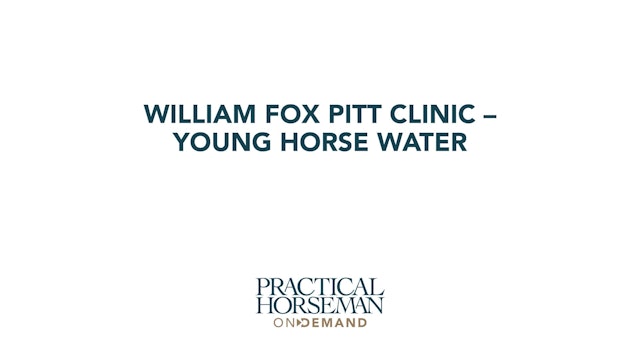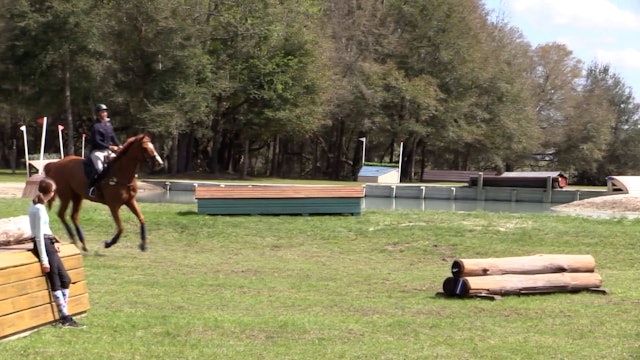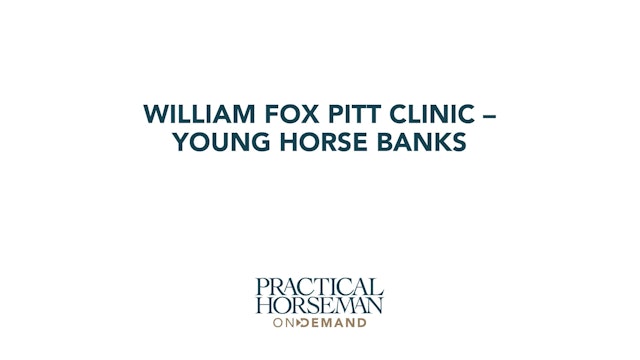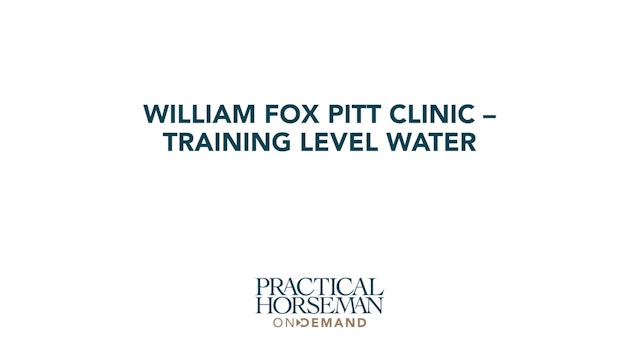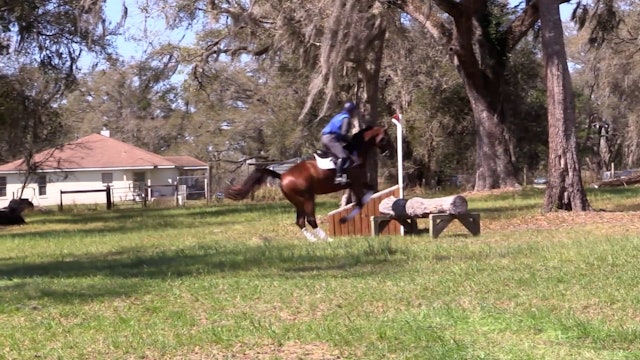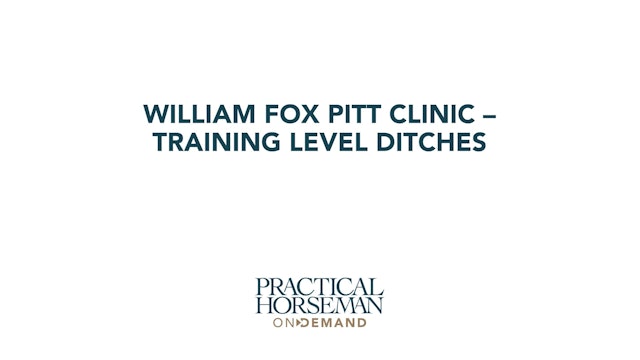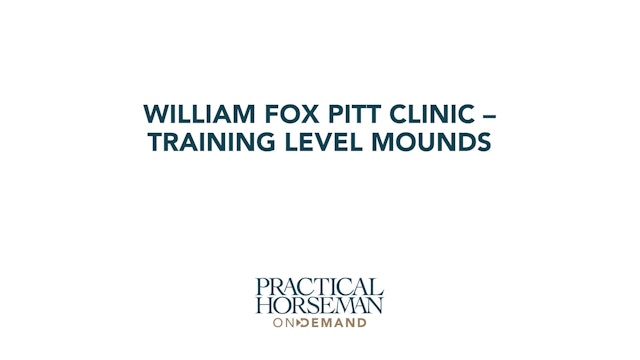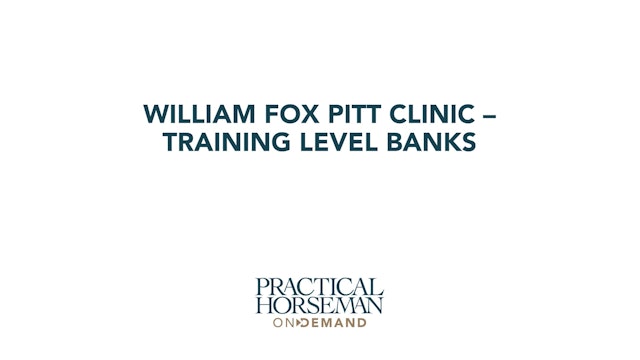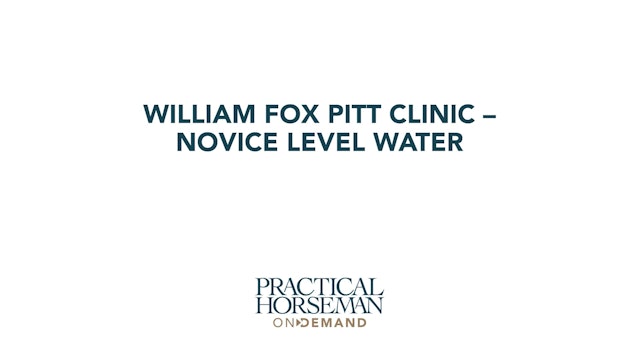-
Young Horse Water | William Fox-Pitt
William has riders canter through the water with jumps at beginning and end. He stresses shortening the canter through the water so the horses don't get too long. He then has them take a small jump up and down into the water, through it and out over a jump.
-
Young Horse Warm-up Course | William Fox-Pitt
William works with a group of riders on young horses. He likes starting the warm-up with low jumps so neither the horses nor the riders worry much. It is easy enough to make the jumps bigger later.
-
Young Horse Ditches | William Fox-Pitt
William coaches riders over ditches first and then ditches with fences before and after the ditch. If the horse spooks and stops at a ditch, William wants him to jump it from a standstill. He reminds riders that they don't need to be nervous, but they do need to stay alert on young horses.
-
Young Horse Banks | William Fox-Pitt
William has them jump up and down a bank. He tells riders to imagine it is level ground with jumps and not think of it as jumping up and down. He wants everyone to stay relaxed. He wants the canter to be collected so that even if they get deep they are still able to jump up or down the bank.
-
Training Level Cross Country - Water | William Fox-Pitt
William puts together a small course featuring the water complex and wants the horses to keep a relaxed rhythm from beginning to end. He stresses shortening the canter through the water so the horses don't get too long and flat.
-
Training Level Cross Country - Warm-up Course | William Fox Pitt
William has riders start over small jumps to warm up. This gives the horses the chance to see some jumps and build confidence. He wants the horses to go in a forward and soft rhythm.
-
Training Level Cross Country - Ditches | William Fox-Pitt
William coaches riders over ditches first and then ditches with fences before and after the ditch. Adding the jumps makes the rider stay straight over the ditch to avoid a run out. If the horse spooks and stops at a ditch, William wants him to jump it from a standstill.
-
Novice Level Mounds | William Fox-Pitt
William wants the riders to keep the same canter rhythm up and down the hills. He doesn't want them to let their horses break to trot. They need to keep cantering, keep their balance, keep their reins short and stay organized.
-
Novice Level Ditches | William Fox-Pitt
William coaches riders over ditches alone first and then with fences before and after the ditch. His emphasis is on riding the horse straight. If the horse spooks and stops at a ditch, William wants him to jump it from a standstill. He stresses to put the leg on and stay with the horse if it hesi...
-
Novice Level Banks | William Fox-Pitt
William has the riders jump up and down a bank. He tells them to imagine it is level ground with jumps and not think of it as jumping up and down. He wants everyone to stay relaxed. The canter should be collected so that even if they get deep they are still able to jump up or down the bank.
-
Novice Level Warm-up Course | William Fox-Pitt
To begin their cross-country school, William has the riders start over small, inviting jumps to warm up. He wants the horses to go in a forward and soft rhythm to stay relaxed. This gives both horses and riders the chance build confidence.
-
Young Horse Mounds | William Fox-Pitt
When galloping and jumping up and down hills, William stresses the riders controlling their own shoulders. He wants to make sure the horses stay cantering, and they do not come back to trot to change leads. He says that they must learn how to change leads themselves, especially on the cross count...
-
Training Level Cross Country - Mounds | William Fox-Pitt
When galloping and jumping up and down hills, William stresses the riders controlling their own shoulders and keeping them up and back to help with their balance and their horse's balance. In addition, he wants them to keep the horses's shoulders straight so they stay straight.
-
Training Level Cross Country - Banks | William Fox-Pitt
The riders next school banks as part of a series of jumps. William advises them not to let the horses get too quick. The horses should have a bouncy canter, and the rider should be sitting up straight. He wants all of the riders to keep looking up and ahead, especially on the down side of a bank.
-
Preliminary Cross Country - Water | William Fox-Pitt
The riders take their horses through the water complex. Most horses handle it in a relaxed manner. William puts together a small course featuring the water and wants the horses to keep a steady rhythm from beginning to end.
-
Novice Level Water | William Fox-Pitt
They end the day at the water complex starting with trotting in and cantering out. When they add a jump, William tells them to keep the canter short through the water so the horses don't get too fast and flat. They finish with a short course that includes the water.
-
Training Level Introduction | William Fox-Pitt
William welcomes everyone and talks to each participant to get to know them and their horses. He also give valuable insight on his training philosophy.
-
Training Level - Canter - Halt - Jump | William Fox-Pitt
William has the riders canter, halt on the line, jump a vertical and then halt again. He wants the riders to make sure the horses are not increasing their pace. It is about making sure the horse is straight, listening and under control.
-
Preliminary Level Introduction | William Fox-Pitt
William welcomes everyone and talks to each participant to get to know them and their horses.
-
Preliminary Level Flatwork Warm-up | William Fox-Pitt
William takes a few moments to watch everyone warm up on the flat. His intention is to get an idea of how the horses go to better understand what they should work on. Generally speaking, he wants the riders to take contact and have the horse in front of the leg.
-
Novice Level - Trotting Fences Warm-Up | William Fox-Pitt
William finds trotting a crossrail beneficial for the horse's footwork to be jumping from a short distance with no speed. By approaching it in walk and then trotting just a few strides before the jump, the horse is forced to actually look at the jump and think about it.
-
Trotting & Walking Fences, Two Star Horses & Riders | William Fox-Pitt | PART 09
Part 9: William works with a rider who has a very free and forward position but tends to lose connection in the bridle. He encourages her to still move the horses feet but be behind her and supporting her in the bridle. As they gain confidence, the riders start to rush the turn and become overly ...
-
Trotting & Walking Fences, Two Star Horses & Riders | William Fox-Pitt | PART 07
Part 7: William notes that some of the riders get in a hurry at related distances which leads them to rushing the horse and breaking the rhythm. He encourages them to focus on riding on a more forward stride between fences, without sacrificing rhythm to achieve it. When on rider is throwing her h...
-
Trotting & Walking Fences, Two Star Horses & Riders | William Fox-Pitt | PART 08
Part 8: William discusses some of the riders bit choice. He notes that they seem to lose power every time they try to make an adjustment. He advises them that personally, he prefers the horse to have less bit, and let the horse feel just a little bit strong in the bridle in order to keep that pow...



